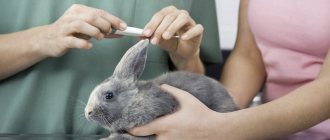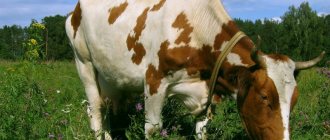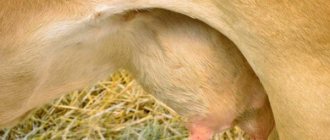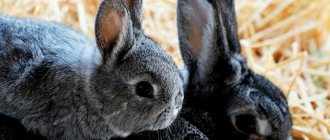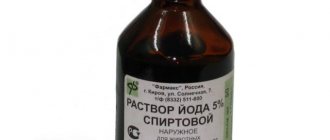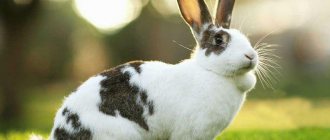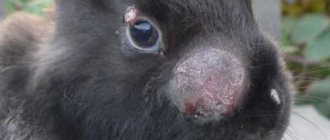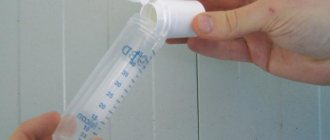Rhinitis in rabbits - causes
Any pathology of a particular organ in the body of any animal does not appear just like that. Everything has its own reason . Rhinitis , which occurs in rabbits, also appears under the influence of certain factors. Knowing these reasons, the owner can prevent the onset of the disease in his long-eared friend.
.
- Let's look at the most basic reasons why rhinitis occurs in rabbits:
- Hygiene
is a very important point that must
be taken into account when keeping rabbits . If you keep your rabbit in inappropriate conditions (the water is rarely changed, the bedding is not washed, the room is poorly ventilated), your pet will immediately catch rhinitis; - Dust
is
one of the most common causes
of rhinitis. As we know, rabbits are often fed hay. The moment the long-eared friend begins to stir him up, a cloud of dust appears, which he inhales. Because of this, irritation of the mucous membrane occurs, resulting in a runny nose; - Fighting
– If you have more than one rabbit, your pets may fight and harm each other.
If that are on the surface of the mucous membrane may be introduced into the blood through abrasions - cell quality
-
the allergic reaction . Some owners prefer cages
made
of plastic
. Because plastic may contain chemicals. They may be poorly tolerated by the rabbit. As a result - rhinitis; - nutrition
- if there is a lack of certain nutrients, rhinitis may occur; - emotional stress
- any stressful situations provoke a runny nose; - air humidity
- if
the air in the room where the rabbit is is too dry
, the nasal mucosa dries out and a runny nose forms; - other irritants
- these include household items that have a pronounced
chemical composition
, household chemicals, cigarette smoke, fragrances, etc.
Why does the disease develop?
Snot in a rabbit often appears due to the physiological characteristics of the structure of the organs of the upper respiratory system:
- The animals have short nasal passages. During inhalation, cold air does not have time to heat up in the too short nasal passages. This is what often becomes a provoking factor in the development of a runny nose.
- Rabbits have poorly developed eyesight. They see poorly in front of them, orientation in space is carried out due to smells. Animals constantly sniff everything, so dust, various allergens, and pathogens enter the nasal cavity, which can cause snot in a rabbit. In this case, the nature of the disease can be different - infectious, viral, allergic, cold.
- The nasal turbinates are very wide and open. The larvae of the sheep gadfly can penetrate into them if sheep are kept nearby. This is a provoking factor in the development of parasitic rhinitis.
Before starting any therapy, it is necessary to establish what is the cause of the disease. With a correct diagnosis, treatment will be much easier, and recovery will come much faster.
The causes of snot in rabbits can be:
- infectious processes;
- colds;
- allergic reaction.
Transmission of infectious rhinitis occurs by airborne droplets, through contaminated objects, equipment, feeders and drinking bowls. The causative agent of the disease can also be transmitted through other domestic animals - cats, chickens, dogs.
Colds often develop as a result of violation of the living conditions of pets. Rabbits can easily get sick when kept in a drafty, cold room. Also, the immune system of animals suffers from an improper diet, if there is a lack of vitamins and microelements, if there are no fresh herbs and vegetables on the menu.
Important! Colds most often appear in animals in winter, early spring and late autumn. In the summer, such a disease is observed in rare cases.
Hay can provoke the development of an allergic reaction. There is a lot of dust in it, so the mucous membranes can react by developing allergies. Experienced rabbit breeders do not recommend setting up cages in dusty corners of the barn. The very sensitive respiratory organs of these animals can immediately respond to negative external factors. Rhinitis will develop upon contact with sick rabbits, with a vulnerable immune system, or with chronic pathologies in the body.
One of the reasons for the appearance of snot is poorly equipped ventilation in the rabbitry. Under such conditions, infectious processes develop quickly. Hypothermia or draft is an equally important reason.
A non-infectious runny nose develops when animals inhale dust from hay or sawdust, as well as mold spores. With hypothermia, inflammatory processes develop in the organs of the upper respiratory system - nasopharynx, larynx, trachea.
Rhinitis in rabbits: types of disease
Rhinitis in rabbits is divided into two types. Which are characterized by differences in the nature of their appearance in the animal’s body. There are:
- cold rhinitis - observed in colds that are caused by hypothermia, the influence of temperature changes, etc.;
- contagious rhinitis - this type of runny nose appears when the body is affected by various viruses and infectious diseases. Since the main reason in this case is microorganisms that have a detrimental effect on the animal, it is much more difficult to treat this form. Can be transmitted from one animal to another.
Stages and types of disease
Rabbits suffer from the following types of rhinitis:
- Allergic – causes may be food, dust, dust, or the presence of allergenic plants.
- Colds - it occurs from drafts, excessive humidity, low temperatures;
- Infectious is a very dangerous form of rhinitis that can affect all rabbits. It is caused by conditionally pathogenic microorganisms staphylococci, streptococci, pasteurella, and E. coli.
- Traumatic - appears as a result of fights or accidental damage to the nasal mucosa.
See also
Why do rabbits die, the main reasons and what to do at homeRead
The most dangerous is infectious rhinitis. Its first stage goes unnoticed. The incubation period lasts up to 5-7 days. As a rule, a runny nose is not acute. If treatment is not taken, it progresses to the chronic stage. In some cases, rhinitis is complicated by bronchitis, pneumonia, blood poisoning and leads to the death of the rabbit.
Infectious rhinitis in rabbits: symptoms
Just like other diseases, rhinitis is accompanied by certain symptoms, which are manifested by changes in the behavior of the animal. It is important to correctly recognize the symptoms of diseases. Since many pathologies have similar signs of manifestation, you can make a mistake
.
The owners’ task is not to make a diagnosis based on the manifestation of symptoms. Your task is to react quickly when you notice a change in the animal’s behavior, which is accompanied by the manifestation of signs of rhinitis. Rhinitis can hide more serious pathologies. Therefore, the sooner you seek help, the greater the chances of receiving competent treatment without complications. Here are the most basic symptoms:
- Here are the most basic symptoms of rhinitis in rabbits:
- change in the color of the nose - it acquires a reddish tint, which is easy to notice with the naked eye;
- changes in the size of the respiratory tract - they increase in size;
- sneezing - the animal constantly exhibits this symptom. Possible “queue of sneezes”
- actively paying attention to the nose - the rabbit begins to scratch its nose, it itches, and may rub it on other objects;
- discharge - can appear either in the form of a clear liquid or in the form of discharge with pus.
In addition to changes in the behavior of the rabbit, there are also pathological changes. Highlight:
- nasal mucosa - this organ is characterized by changes in the mucous membrane itself. It turns red and becomes denser. There is also a large accumulation of secretions in the nasal cavity;
- trachea - on the trachea itself the appearance of numerous blood vessels is observed. And the walls of the trachea may be covered with copious amounts of pus;
- lungs - there is a change in size. They seem to be swelling. The color changes - the lungs darken. There is also a dangerous symptom - abscesses, which are accompanied by the presence of certain capsules with pus. If this happens, it signals decomposition of the lungs.
Symptoms
Colds can be infectious or non-infectious.
In this case, general symptoms are observed, by which the problem can be identified and treatment measures taken. Read more about the different forms of colds, pathogens and symptoms below.
Non-infectious
Often, a rabbit may develop colds that are not infectious.
They are usually associated with the fact that the pet is cold and caught a cold, was exposed to a draft, or was outside the house in bad and humid weather.
Often a similar problem occurs when there are sudden changes in temperature from high to low and vice versa. In general, colds are caused by external influences.
Its symptoms will be:
- frequent pet sneezing;
- rhinitis and nasal discharge, most often the discharge is clear or whitish;
- a crust forms around the nose;
- sometimes there is an increase in temperature;
- There may be problems with feeding, appetite, and decreased activity.
Such a cold can have a mild form, which the pet can cope with on its own in a few days. But if the condition worsens, the rabbit behaves unnaturally and feels worse and worse, it will need treatment.
It is better to consult a doctor.
And you definitely need to monitor the conditions under which the animal is kept - room temperature, feeding, amount of sun, change the bedding on time and ventilate the room.
It is not recommended to take your pet for long walks outdoors in rainy or cold weather. This will help prevent colds from occurring.
Infectious
The cause of any infectious disease is most often bacteria or viruses.
The causative agents are usually streptococci, staphylococci, bordetella, pasteurella and others. They are usually carried not only by sick individuals, but also on animal fur, food or hay for bedding, clothing, etc.
The infection is characterized by the following symptoms:
- green or white nasal discharge;
- tearing or inflammation of the mucous membranes of the eyes;
- swelling of the nose (redness and enlargement) or eyes;
- cough, wheezing, or shortness of breath;
- increase in temperature, usually sharp and strong;
- lethargy and lack of appetite;
- The pet may also be in a depressed mood.
Diagnosis of rhinitis in rabbits
Before prescribing treatment, it is necessary to diagnose the rabbit. Correct diagnosis is practically the key point in the fight against the disease. After all, if you make a mistake, the treatment will be directed in the wrong direction and will only provoke a stronger impetus for the development of the disease.
- Let's look at what
examinations for rabbits
- When making a diagnosis, a veterinarian may prescribe:
- initial examination by a veterinarian - a specialist must assess the pet’s condition through a visual examination (body, mucous membranes, nose, discharge). It is also necessary to provide information to the doctor about changes in the pet’s condition over the last 72 hours;
- Blood tests help determine the state of the body as a whole. A biochemical blood test can show the results of the values responsible for the functioning of various organs;
- analysis of secretions - help to determine whether they contain harmful microorganisms;
- Ultrasound examination and radiography - in order to exclude the presence of mechanical injuries, various neoplasms, as well as if a parallel course of other diseases is suspected, these measures are prescribed.
If necessary, the veterinarian may prescribe additional examination. After confirming the diagnosis, it is necessary to prescribe competent treatment, which we will talk about in the next paragraph.
Traumatic rhinitis
A relatively rare cause of rhinitis. When identifying signs, look carefully for damage to the bridge of the nose. Be sure to look into the nostrils. Sometimes stuck plant seeds (feather grass, dandelion, burdock) and others are found in the nasal passages. Sometimes stuck foreign objects create obstruction to the movement of air in the nostril on one side; rarely, bilateral air obstruction is detected. In this case, the rabbit breathes with its mouth open. Seek help from your veterinarian immediately. Removing a foreign object from the nostrils and restoring the passage of air is possible only in a veterinary clinic, often under anesthesia.
Rhinitis in rabbits treatment
There are different methods and methods for treating rhinitis in roller skates . Each case is individual and requires specific analysis. If your doctor finds rhinitis in your rabbit, he may prescribe two treatments:
the most
common ways
. Let's take a closer look at them:
Treatment of rhinitis by using injectable drugs - in this case, intramuscular injections are given, which contain one of the drugs (ribotan, maxidin, fosprinil). As a rule, injections are given over five days. Then, after two weeks, the course is repeated. For complete recovery, 5 courses are necessary. This method is very effective, but not the most common, since many owners are embarrassed by frequent injections. Treatment of rhinitis by using special drops is a more popular method among rabbit breeders, since dropping drops several times a day seems more humane. The drug must be used 6 times a day.
All information is provided for informational purposes only. Do not try to self-medicate your pet under any circumstances. This can have a bad effect on his health and cause complications of the disease. Also, when choosing medications, priority should be given not to your preferences, but to the recommendations of the attending physician. The specialist knows best which treatment method is best for your animal.
Preventive measures
To reduce the likelihood of developing a runny nose in rabbits, it is important to comply with all the necessary conditions of care and maintenance. It is necessary to clean the cages on time; regular disinfection is mandatory. It is necessary to arrange the cages in such a way that they are free from dampness and drafts. Animals should also not be allowed to become hypothermic.
The diet should be balanced, rich in all necessary vitamins, micro- and macroelements. A rabbit breeder should regularly examine his rabbits in order to detect symptoms of colds in time. A sick animal must be immediately isolated from its relatives.
To prevent the development of colds, you can give your pets propolis. It must first be diluted in warm water and used several times a week instead of water.
If you notice any suspicious symptoms, do not hesitate to contact a veterinarian. Only a qualified specialist is able to conduct a competent diagnosis, make the correct diagnosis and, in each specific case, prescribe the most appropriate treatment. It is prohibited to use medications on your own.
Prevention to avoid rhinitis in rabbits
Preventive measures can help you protect your pet from diseases. All efforts should be aimed at improving the maintenance of rabbits and avoiding contact with pathogenic microorganisms.
- Here are some recommendations compiled by leading experts:
- it is necessary to monitor the hygiene of the animal;
- You need to focus on nutrition - proper nutrition is the key to health. The combination of all nutrients, coupled with vitamins and minerals, will definitely strengthen the rabbit’s immunity;
- Avoid getting into fights with other animals - this doesn't just apply to other rabbits. Any pets with whom there may be conflict should not have free access to the rabbit;
- take into account the genetic characteristics of the rabbit - the animal may be allergic to certain items. This must be taken into account.
Parasitic runny nose
Usually this is nonspecific rhinitis, which is caused by parasites that are not specific to the rabbit (botfly larvae, protozoa, fungi). Rabbit helminths have not been observed to participate in the pathogenesis of the common cold. So, the rabbit is sneezing and snot, what should you do?
- Parasitic rhinitis in the rabbit, caused by the larvae of oestrus, the nasal botfly of sheep, can occur exclusively in rural rabbits kept near sheep in areas unfavorable for oestrus in sheep. Outbreaks occur exclusively in summer, during the active summer of insects. The gadfly in flight injects first-stage larvae into the nasal passages of sheep; sometimes rabbits become victims of the attack. The disease is manifested by profuse, stringy nasal discharge, restlessness, itching and scratching in the nasal area. The disease stops after a month without treatment. To quickly eliminate symptoms, ivermectin preparations are administered subcutaneously at a dose of 0.3 ml.
- In the Russian Federation, worms, which during migration through the rabbit’s body and enter the nasal passages, do not exist. In dogs and cats, parasites migrating through the respiratory tract are some types of roundworms. Such pathologies do not occur in rabbits.
- If the rabbit sneezes and there is white snot. This usually means that the purulent exudate contains protozoan parasites in the form of amoebas or microscopic fungi. In order to plan measures to treat a runny nose, you need to conduct a laboratory study of mucus.
Treatment of infectious rhinitis.
The specificity of this disease is that it, as a rule, quickly spreads throughout the entire farm. Often isolation and quarantine do not have the desired effect. While you are treating some rabbits, others manage to become infected from them. Therefore, many rabbit breeders, having spent a lot of time, effort and incurring financial expenses, are left broke. There is an opinion that it is not advisable to treat the farm. It is much easier to slaughter the entire herd, carry out a thorough disinfection and start all over again. However, this is not entirely true, especially if we are talking about the early stage of the disease. If it is not possible to go to a veterinary hospital, you can independently treat rabbits with a saline solution of Ecmonovocillin (one percent), instilling five drops into the rabbit’s nostril. This medicine can be replaced with Furacilin and diluted in the same proportion. Recently, another effective medicine has appeared - Hemomycin. A quarter of the tablet is crushed in two ml of water and the resulting suspension is given orally once a day for 3-5 days. Even rabbits with an advanced form of the disease can be treated.
Chlorine-turpentine inhalation can prevent the spread of infection. You need to mix 2 grams of dry bleach with 0.5 milliliters of turpentine per 1 square meter of room in a metal bowl. All doors and windows of the room must be closed and ventilation turned off. After the air is saturated with chlorine-turpentine vapor, it is kept in this state for 25 minutes, then the rabbitry is ventilated.
In the next article, read about an effective method of treating infectious rhinitis. veterinarian Irina Tylik shares her experience with you I wish everyone good luck.
Please share this article with your friends on social networks:
Please rate the article. Ask a question, discuss on the forum.
Causes
- Infections. This is the development of inflammation of the mucous membranes of the respiratory tract due to the proliferation of pathogenic flora on them. Rhinitis can be caused by bacteria, viruses, fungi and protozoa.
- Decreased immunity due to hypothermia, overheating, poor nutrition, deficiency of vitamins and minerals, lack of care and failure to comply with basic hygiene measures for cleaning premises with animals, changing bedding, and processing drinking and food utensils.
- Injuries to the nasal passages, entry of foreign bodies (dust, dirt) into them.
- Chronic diseases of rodents (pathologies in the digestive, endocrine and respiratory systems).
- Allergies to food, dust, fluff, wool.
Transparent and liquid discharge from the nose of animals is usually a sign of allergic reactions and is accompanied by frequent sneezing and coughing, and can also be observed when rodents are infected with acute viral infections in the initial stages of the disease, weakening the body's defenses during low-grade inflammatory processes.
White snot in a rabbit indicates the proliferation of protozoan pathogens (amoebas, proteus) or infection with fungi. In the first case, the discharge is viscous and mucous, in the second it is a cheesy white mass. Most often, in diseases caused by bacteria, rabbits have purulent snot; it is very thick and, when dried, forms hard crusts in the animal’s nose. Often such formations clog the respiratory passages of rodents and they die.
Blood in the nasal discharge appears when small vessels in the nasopharynx of rabbits are injured; this can be provoked by the presence of foreign bodies in it or inflamed areas covered with dried mucus or pus. In addition, animals can scratch their nose and scratch it with their claws.
Rabbit snot and sneezes
Bacteria and viruses can cause snot in a rabbit. The accumulation of bacteria can lead to diseases such as bronchitis and even pneumonia. If treatment is neglected, death and infection of other animals is possible.
First the rabbits rub their noses, and then they start snotting. It is necessary to consider the most common diseases and their treatment. Since the inflammatory process begins with a runny nose, you need to start treating the mucous membrane immediately. Symptoms of a non-communicable disease:
- cough;
- lacrimation;
- dyspnea;
- temperature;
- wheezing;
- whistling during breathing;
- fatigue;
- prostration.
Did you know? There is a breed of the smallest rabbits in the world called pygmy. Their sizes are tiny, because the body length can be a maximum of 28 cm, and the weight varies from 200 to 500 g. They live in the northwestern United States and are listed in the Red Book.
Rhinitis
A common draft, strong wind and sudden changes in temperature can provoke cold rhinitis. Most often, rabbits whose immunity is not fully formed become ill. They often begin to get sick in the fall or winter, when the weather outside changes most often.
This is when rabbits snot and may develop a fever. The animal constantly shakes its head and rubs its nose with its paws. The nose begins to swell and a white discharge forms on the outside, and a dried crust appears around the nose. Then the rabbit begins to breathe through its mouth.
Infectious rhinitis is accompanied not only by sneezing, lacrimation, but also shortness of breath. The rabbit's breathing becomes difficult; whistling and wheezing can be heard in the lungs. If treatment is not carried out in time, this cold will simply develop into a serious form of the disease, for example:
- pleurisy;
- bronchitis;
- pneumonia;
- purulent pneumonia.
And then the pet will simply die in a matter of months.
It is necessary to begin treatment by transplanting the rabbit to another warm room.
There, crusts are removed from his nose using hydrogen peroxide, then his nostrils are lubricated with Vaseline. Next, you need to dilute novocaine with penicillin, this solution is dripped every day for two weeks, 10 drops. You can stir furatsilin with boiling water and treat your pet using the same principle as mentioned above. Sometimes they resort to the use of antibiotics. What to treat and how, we will now consider. The following drugs can be used:
- chloramphenicol 25 ml per kg of live weight;
- baytril 2.5% - give an injection;
- Marbocil 2% - administered by injection.
Antibiotic treatment lasts a week. Even if your animal feels better after a couple of days, there is no need to stop treatment. If you do not want to resort to drug treatment, you can try to improve the condition with folk remedies. In this case, you will have to use inhalation with decoctions of mint, sage, and thyme.
Did you know? The longest ears are possessed by a rabbit named Nippers Geronimo, whose ears are 79.05 cm in length. This event is included in the Guinness Book of Records.
You can add a drop of essential oil to 2 liters of water, then you will not need to make a decoction. Treatment lasts about a week, otherwise the mucous membrane can simply dry out. There is no need to make a concentrated solution, because it will not cure, but will only cause discomfort to the animal.
To carry out the process, it is necessary to transplant the animal into a small cage with hay and a saucer of water. Next, cover it with a towel for 5 minutes, but leave a small hole for air to enter. This way the patient will breathe healing steam. This procedure is done about three times a day. If your pet has increased white nasal discharge, this is completely normal.
